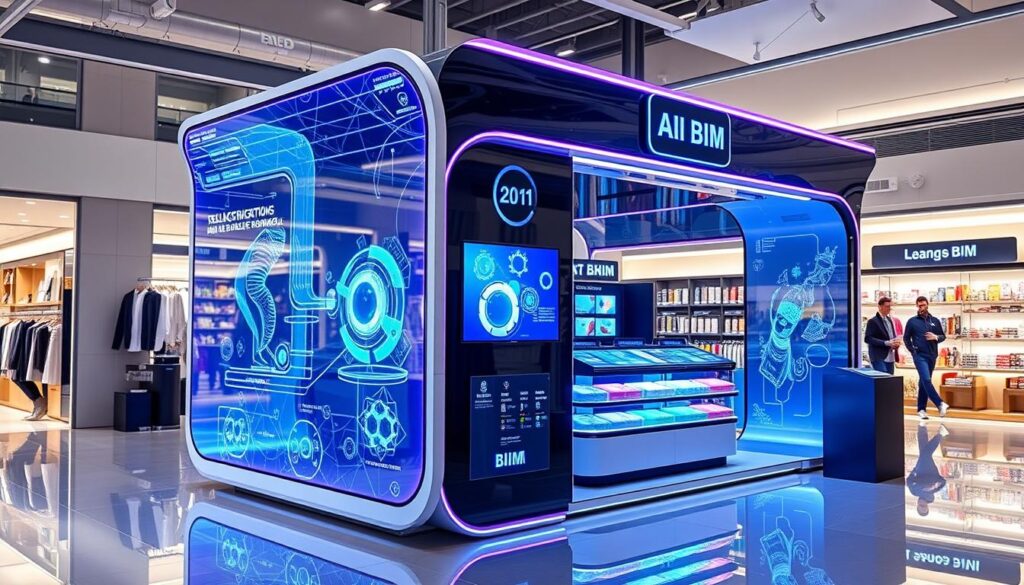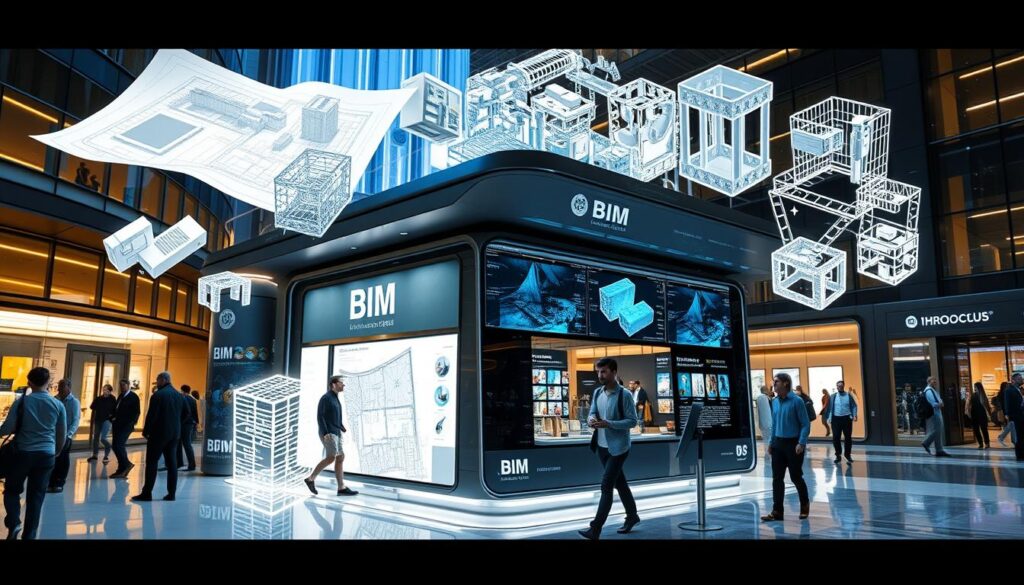Retail kiosks have changed the way we shop, making it better and faster. They are popular in malls, airports, and offices. These self-service machines let customers buy things quickly and get information fast.
They meet the needs of people who like to shop in new ways. BIM in retail design helps make these kiosks even better. They make shopping quicker and more convenient, available 24/7.
This approach also saves money by needing fewer staff. It helps fight retail theft, which costs a lot. Plus, it lets stores use space better and keep up with new trends.

Key Takeaways
- Retail kiosks enhance consumer experiences through interactivity and accessibility.
- BIM technology streamlines design, planning, and implementation processes for kiosks.
- Effective use of space is key in placing kiosks for the best visibility.
- Retail theft is a big problem, making efficient solutions essential.
- BIM improves teamwork, making things more efficient and saving money.
- Data insights help tailor offers, making customers happier.
- Retail kiosks are good for the environment, thanks to smart tech.
What is BIM (Building Information Modeling)?
Building Information Modeling, or BIM, is a big step forward in architecture, engineering, and construction. It uses digital models to show the physical and functional parts of buildings. This helps manage projects better from start to finish.
The first computer-aided machining software came out in 1957. The term “Building Information Model” was first used in 1992. This marked a big change towards using digital tools in building design.
Explain the concept of BIM and its role in modern architecture, engineering, and construction.
BIM is a shared resource for teams to work on projects together. It lets architects and builders see detailed designs of retail kiosks clearly. This has changed how the industry works, making things more efficient.
With BIM, teams can talk better and avoid mistakes. This creates a space where everyone can share ideas and innovate together.
Emphasize the key aspects of BIM, such as 3D modeling, data integration, and collaboration.
Building information modeling has three main parts: 3D modeling, data integration, and teamwork. 3D modeling helps create detailed designs for retail kiosks. It shows what the final product will look like.
Data integration keeps everyone on the same page with the latest information. This helps make better decisions. Teamwork is key in BIM, as everyone works together on one model. This teamwork makes projects better and prepares the way for more BIM technology in the future.
The Convergence of Retail Kiosks and BIM
The use of Building Information Modeling (BIM) in retail kiosks is a big step forward. It makes both design and operation better. As retail kiosks become more automated and digital, using BIM is key. This method helps in designing, planning, and setting up kiosks more efficiently.
How BIM Can Be Applied to the Design, Planning, and Implementation of Retail Kiosks
BIM is a powerful tool for retailers wanting to improve their kiosks. It helps in designing kiosks in detail, so businesses can meet customer needs. It uses real-time data to understand where kiosks should be placed for the best experience.
With more touchscreens coming, BIM helps place them where they’re most useful. This makes shopping easier and more enjoyable.
The Advantages of Using BIM for Kiosk Projects
Using BIM in retail design has many benefits. Some of the main advantages are:
- Improved Visualization: Designers can make 3D models that look real. This lets everyone see the kiosk before it’s built.
- Clash Detection: BIM finds problems early, making installation smoother and saving money.
- Cost Estimation: It helps predict costs accurately. This keeps projects on budget.
- Resource Optimization: BIM lets retailers plan better. This makes operations more efficient.
As self-service tech grows, BIM helps retailers stay ahead. It prepares them for new technologies that change how we shop.

| Advantages of BIM in Retail Kiosk Projects | Description |
|---|---|
| Improved Visualization | Creation of interactive 3D models for better stakeholder engagement. |
| Clash Detection | Identification of conflicts before installation, minimizing disruptions. |
| Cost Estimation | Accurate financial forecasting to maintain control over budgets. |
| Resource Optimization | Strategic allocation of resources to enhance operational efficiency. |
BIM Applications in Retail Kiosk Design
Building Information Modeling (BIM) makes retail kiosk design better. It helps retailers use advanced tools for better store layouts. This means kiosks are placed where they’re most seen and used.
Space Optimization
BIM is key for better use of space. It helps find the best spots for kiosks to draw more people. This makes shopping more engaging as kiosks are easy to find and use.
Kiosk Design and Customization
BIM lets retailers design kiosks in detail. They can make 3D models and try out different looks and features. This way, kiosks reflect the brand and meet customer needs, making shopping more personal.
Integration with Existing Infrastructure
BIM also helps kiosks fit well with the store’s setup. It ensures kiosks work with electrical and network systems and flow with customer paths. This makes shopping smoother and more enjoyable.

BIM for Retail Kiosk Fabrication and Installation
Using BIM in making and setting up retail kiosks makes things better. It combines detailed models with advanced data, leading to a smoother process. This makes the whole setup of kiosks more efficient.
Streamlined Manufacturing
BIM models help make detailed drawings and instructions for making kiosks. This reduces mistakes and improves the quality of the final product. It also helps avoid misunderstandings by clearly sharing plans.
There are many BIM-ready products available, like fittings and equipment. These are key for making and building kiosks well.
Efficient Installation
BIM gives teams the tools to plan and manage the installation well. This planning reduces disruptions and makes the transition smooth. It also helps in managing time and resources better.
Overall, BIM leads to faster project completion and less chance of delays or extra costs.
BIM and the Future of Retail Kiosks
Retail kiosks are changing fast, thanks to new tech. Now, they’re key for talking to customers and making shopping smoother. Trends show a big move to kiosks that use AI to know what shoppers like. These kiosks then suggest things that fit each person’s taste, making shopping better.
Emerging Trends in Retail Kiosk Technology
New tech is making kiosks more important in stores. Some big changes include:
- AI lets kiosks understand and talk back to customers.
- They can now offer personalized experiences, making shopping more fun.
- They work well with mobile apps, making shopping easier.
Facilitating Advanced Technology Integration through BIM
BIM is key for adding new tech to kiosks. It helps retailers see how to add cool features without losing the kiosk’s look. BIM makes designing easier by giving:
- Clear 3D models to see how the kiosk works.
- Details on what tech is needed and where it fits, making setup easier.
- Tools for teams to work together and stay on the same page.
BIM is a big help in making kiosks better. It makes shopping more fun and efficient for everyone.
Case Studies: Successful BIM Implementation in Retail Kiosk Projects
Many case studies show how BIM has changed retail kiosk projects. It has improved design, efficiency, and customer experience. These examples show how BIM makes processes smoother and boosts performance. Companies use advanced kiosk technology to create better shopping experiences, with BIM as a key tool.
Real-world Examples of Effective BIM Applications
BIM has helped companies rethink kiosk designs and workflows. By studying data from various projects, they found ways BIM enhances retail kiosks. Some notable examples include:
- Hudson Yards Development: BIM was used for detailed 3D models of kiosks, improving customer interaction.
- Large Shopping Center in East China: A BIM model was created to measure success in several areas.
- U.S. Airports: Airports like Denver and San Francisco used BIM to better manage kiosk assets.
Benefits and Outcomes Achieved through BIM Implementation
Studies on BIM projects in retail show many benefits. These include:
| Benefit | Description |
|---|---|
| Improved Design Accuracy | BIM cuts down design errors, making kiosk integration smoother. |
| Enhanced Customer Experience | Interactive kiosks make shopping more engaging. |
| Cost Efficiency | Using BIM saves time and money in projects. |
| Streamlined Operations | BIM helps plan and install efficiently, improving workflows. |
These studies show a big change where BIM and kiosk technology meet. They create a more efficient, customer-focused space. By understanding BIM’s benefits, companies can innovate and succeed in the competitive retail world.
Conclusion: BIM as a Key Enabler for Retail Kiosk Success
Building Information Modeling (BIM) has changed the game for retail kiosk projects. It brings many benefits that improve both design and setup. With BIM, everyone can see what the kiosk will look like before it’s built. This helps spot problems early, making the whole process smoother.
BIM also makes sure all technical details are correct. This cuts down on mistakes and misunderstandings. As a result, setting up the kiosk goes faster and there are fewer delays.
The retail world is always changing, and BIM is more important than ever. Traditional building methods waste over 57% of time. But with BIM, businesses can work more efficiently and make fewer mistakes.
By combining new technologies with BIM, companies can keep up with what customers want. This helps them stay ahead in the market.
In the end, using BIM leads to new ideas and a more efficient way to do things. It helps businesses face the future with confidence. They can give customers the best experiences possible.
FAQ
What are the main benefits of using retail kiosks in modern retail environments?
Retail kiosks make shopping faster and easier. They cut down on waiting time and are always ready to use. They also save money by needing fewer employees and costing less to run.
How does BIM improve the design process for retail kiosks?
BIM makes designing kiosks better by using 3D models. This lets designers try out different looks and see how kiosks fit in spaces. It also helps teams work together better and avoid mistakes.
What technologies are typically integrated with retail kiosks through BIM?
Kiosks can use cool tech like AI and touch screens. BIM helps show how these techs fit with the kiosk’s look and function.
Can BIM help optimize the placement of kiosks within a retail space?
Yes, BIM lets retailers see how different layouts work. This way, kiosks can be placed where they get the most attention and use.
What role does BIM play in the fabrication and installation of retail kiosks?
BIM makes making kiosks easier by giving clear plans. It also helps plan how to set up kiosks without causing trouble in stores.
How has the use of BIM influenced recent trends in the retail kiosk industry?
BIM helps bring in new trends like smart kiosks. It lets stores offer unique experiences that meet today’s tech-loving shoppers.
Are there successful case studies showing the use of BIM in retail kiosks?
Yes, places like Hudson Yards show BIM’s benefits. It makes designs more accurate, cuts down on mistakes, and boosts customer interaction.
What sectors are currently utilizing retail kiosks?
Kiosks are used in malls, airports, and offices. They’re great for places where people need quick info or services.